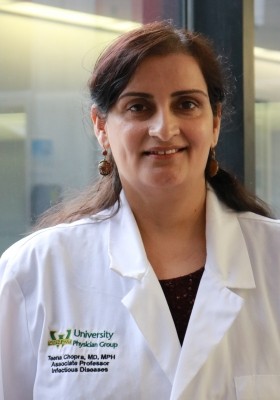Michigan riding ‘second’ COVID wave that could bring more deaths
October 14, 2020
Michigan’s battle with the novel coronavirus has taken a sharp turn, with the volume of cases sharply increasing almost daily along with hospitalizations, emergency room visits and deaths.
For the past week, there have been over 1,100 newly confirmed cases a day. More than 1,000 people with COVID-19 are now in Michigan hospitals, following a recent low of 500 on Sept. 25.
And deaths, which had been low, are creeping up in a likely “second wave” that will bring more cases — and more heartbreak.
Dr. Joneigh Khaldun, Michigan’s chief medical executive and deputy director of the state health and human services department, said Tuesday that average daily deaths, now at 13, while still far lower than during the initial outbreak last spring, are at their highest levels since then.
“We will potentially and quite frankly likely see those deaths increase,” Khaldun said during a news conference with other state health officials.
The news comes as neighboring states are hitting their highest case levels ever and the winter flu season looms, bringing the potential for overloaded hospitals that could be stretched to capacity.
A potential surge would come as many are suffering from “pandemic fatigue” that comes after seven months of mask mandates, social distancing and economic shutdowns.
“Our case rates in our hospitalizations are rising and now that the weather is getting colder and people are less likely to do outdoor activities, it’s more important than ever” to take precautions to protect families and neighbors, Khaldun said.
“Remain vigilant. Take this seriously no matter what part of the state you live in. Things like wearing masks, avoiding large gatherings … washing hands frequently; those things work. Stay home if you are sick so you do not spread the disease to others.”
Health officials are seeing caseloads and hospitalizations increase across every region of the state. And a greater percentage of coronavirus tests are coming back positive, indicating wider spread of the disease. On Tuesday, the state reported that 4.7 percent of tests were coming back positive, the highest rate since late May and well above the target of 3 percent or lower.
While the Upper Peninsula has been leading the state in new cases on a per capita basis, other areas are showing marked increases, too: The Grand Rapids, Kalamazoo and Lansing regions are seeing their highest case counts since the pandemic began, Khaldun said.
Brian Peters, CEO of the Michigan Health and Hospital Association, said hospitals across the state are seeing rises in cases, from the emergency room to the intensive care units. Staffing has been tough in some because employees have had to quarantine because of coronavirus exposure, he said.
In the spring, Michigan was one of the leading states in coronavirus cases and deaths, with over 3,000 dying in April alone. But after Gov. Gretchen Whitmer enacted emergency orders that shuttered businesses and schools and required mask usage, cases went down dramatically and the state was later able to reopen much of the economy.
But as cases have begun to rise and after the Michigan Supreme Court recently ruled Whitmer can no longer impose emergency restrictions without the input of the Legislature, there is less certainty about what steps the state will now take to halt further increases.
Peters, of the hospital industry group, said he is hopeful state leaders and residents will make safe choices.
“We must stop this trend and we must stop it now,” he said.
Less deadly
The recent rise in COVID-19 infections has not brought with it the volume of deaths suffered last spring. Cases are more widely distributed across the state and therapies and treatments have improved in Michigan, as they have elsewhere.
Peters said demography has helped, with many of the new cases in August and September among younger residents, such as students, who are less likely to get seriously ill. But medical professionals have also learned how to better treat COVID-19, he said.
“We’re learning as we go and I think the willingness of [hospitals] to share with each other and with their counterparts and other states as well… this is a learning curve for everybody and certainly there is good news to share.”
Experts attribute the improved outcomes to a host of factors. Fewer patients spread across more hospitals have allowed for better care. Treatments have changed and some therapies have emerged, like using remdesivir, which aided in President Trump’s recovery.
And after the coronavirus ravaging nursing home residents in Michigan and elsewhere, changes were made to better protect those populations and many more are taking their own precautions, such as wearing masks and avoiding crowds.
“All these precautions are definitely helping,” said Dr. Teena Chopra, a professor of infectious diseases at Wayne State University who is in charge of infection control at Detroit Medical Center.
Chopra said she has noticed that patients she sees at the Detroit Medical Center are younger, by about a decade, than those who were arriving in March and April. That’s made them more resilient to COVID-19. But it doesn’t mean it’s no longer to be feared.
“The virus is not going to magically disappear,” Chopra said.
Continue reading, “Michigan riding ‘second’ COVID wave that could bring more deaths” from Bridge Michigan.
Learn more about Teena Chopra, M.D., M.P.H., at WayneHealthCares.org.
